|
Throughout the year, over 190 bird species can be seen in Big Cypress National Preserve! Some species are only here for a season, while others make the preserve their home year round. Click here to view our Bird Checklist, or read on to learn about some of the birds you might see in the preserve. 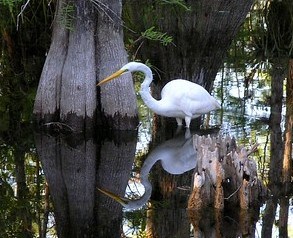
Herons, egrets, and the other long-legged birds that hunt the shallow waters of Big Cypress are often collectively referred to as wading birds. 16 species of wading bird are known to occur in the preserve, making members of this diverse group some of the most commonly spotted birds in Big Cypress. 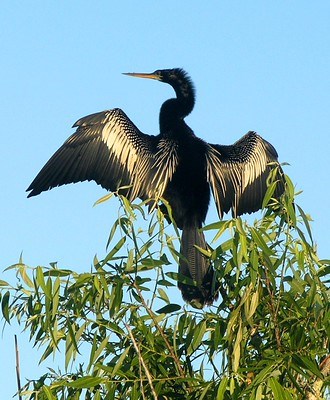
Appearance: Anhingas are sleek, black birds with white feathers creating streaks down their back and upper wings. They have a fan-shaped tail, a long, thin, neck and a sharp, pointed bill. Females can be distinguished from males by their tan head and neck. Size: Adult Anhingas are 2.5-3 ft. in length with a ~3.5 ft. wingspan. They weigh 2.7-3 lbs. Habitat: Anhingas prefer freshwater marsh and swamp habitats with slow, sheltered water and perches for sunning themselves. Diet: Anhingas feed primarily on small fish that they spear with their pointed beak and swallow headfirst. They are also known to eat some crustaceans, invertebrates, amphibians, snakes, and even young alligators. Reproduction: Anhingas usually nest in colonies, often with herons, cormorants, and other waterbirds. They are monogamous and may return to the same nest season after season. The female lays 2-5 eggs in the spring or early summer that are incubated for ~4 weeks. Both parents participate in incubating and feeding their offspring. 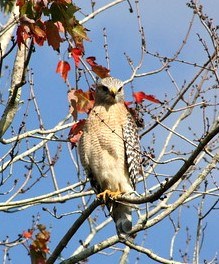
Appearance: In Florida, adult Red-shouldered Hawks have a pale gray head, a barred, rusty-colored breast, a black and white-striped tail, and dark and white-checkered wings. Juveniles have a brown head and back with brown patterning on their wings, breast, and tail. In other parts of the United States, Red-shouldered Hawks have a brown or rust-colored head and brighter rust coloration overall. Size: Red-shouldered Hawks are 1.4-2 feet in length with a 3.1-3.6 foot wingspan and weigh 1.1-1.7 lbs. Habitat: Red-shouldered Hawks are found in forested areas, including cypress swamps, upland mixed forests, and along the edge of streams. They prefer an open understory for easier hunting. Diet: Red-shouldered Hawks eat small mammals, reptiles, amphibians, crayfish, and sometimes other birds. They hunt primarily from perches, gliding down to grab prey that they spot. Reproduction: Red-shouldered Hawks are monogamous, often returning to reuse a previous year’s nest. The female lays 2-5 eggs that are incubated for 32-40 days. The female performs most of the incubation and caring for the young, while the male supplies the nest with food and may occasionally incubate the eggs while the female eats. 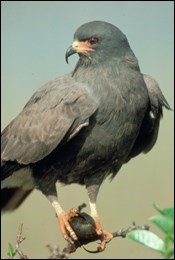
Appearance: This raptor has broad wings, a slender, curved bill, and a thick black band across its white tail. Males and females are easily distinguished, with males appearing dark grey while females are brown with cream streaking on the breast, cream around the face, and a cream eyebrow. Size: Adults are around 1.2-1.4 feet in length with a 3.5-3.8 foot wingspan and weigh between 0.75-1.25 lbs. Habitat: Snail Kites can be found in freshwater marshes, wet prairies, and other shallow, vegetated areas where apple snails can be found. The vegetation needs to be fairly open to allow the foraging kites to see their prey. Diet: A Snail Kite’s diet consists almost exclusively of apple snails (genus Pomacea, specifically the native Florida apple snail P. paludosa.) They use their narrow, hooked beak to remove the snails from their shells. Rarely, snail kites are known to eat other animals, including small turtles, crayfish, snakes, and fish. Reproduction: Female Snail Kites lay 1-5 eggs that are incubated by both parents for 24-30 days. Both parents feed the chicks for 3-6 weeks after hatching. Then, one parent (male or female) often leaves to find another mate and nest again while the remaining parent continues to care for the young until they are 9-11 weeks old. 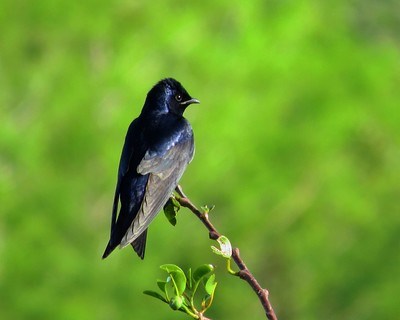
Appearance: Male Purple Martins are a dark, iridescent blue-purple with a brown-black tail and wings. Females and juveniles are dark above with pale undersides and a grey collar and forehead. Long wings, a shallowly-forked tail, and a slightly hooked bill also mark this swallow species. Size: The largest swallow species in North America, Purple Martins are 7.5-8 inches in length with a 15.3-18 inch wingspan. They weigh ~0.1 lbs. Habitat: Purple Martins forage over open habitats such as fields and wet meadows. They originally nested in tree cavities, but today individuals in the eastern United States live almost exclusively in man-made nesting boxes placed near water. For winter they migrate to South America. Diet: Purple Martins feed on a variety of flying insects, including dragonflies, grasshoppers, bees, and flies. They will also eat spiders. Martins consume small pieces of gravel to help them digest insect exoskeletons. Purple Martins do most of their foraging while in flight, catching their prey mid-air. They will also drink while in flight, skimming a body of water and scooping up a drink with their lower bill. Reproduction: Purple Martins form pair bonds between one male and one female, but both sexes frequently mate with other birds. The female lays 3-8 eggs that are incubated for 15-18 days. Incubation is performed by the female, and both parents help feed the hatched nestlings. 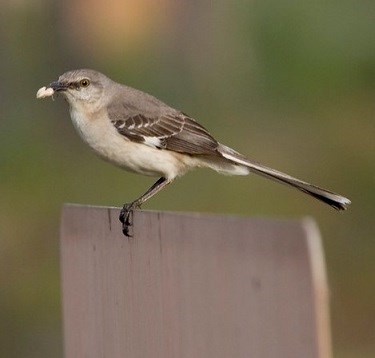
R. Cammauf Appearance: This songbird is pale grey with whitish undersides, a thin, dark eye-stripe, and two white bars on its wings. In flight it displays flashy white wing-patches and a line of white along each side of its long, grey tail. Size: Northern Mockingbirds are 8.3-10.2 inches in length with a 12.2-14.0 inch wingspan. They weigh ~0.1 lbs. Habitat: Northern Mockingbirds can be found in a variety of open and shrubby habitats, including farmland, the edges of forested areas, and suburban yards and hedges. They are often easily spotted as they sit and sing on high, exposed perches such as trees and fences. Diet: Insects, such as grasshoppers, ants, and wasps, make up most of the Northern Mockingbird’s diet in the late spring and summer, along with the occasional small lizard. They can often be seen foraging for insects while walking or running along the ground. In the fall and winter, they switch to eating mostly fruit. Reproduction: Female Northern Mockingbirds lay clutches of 2-6 eggs that are incubated by the female for 12-13 days. Once the eggs hatch, both parents feed the young. Northern Mockingbirds may lay 2-3 sets of eggs in a year, with the female sometimes laying eggs in a second nest while the male is still tending to the juveniles from the first brood. 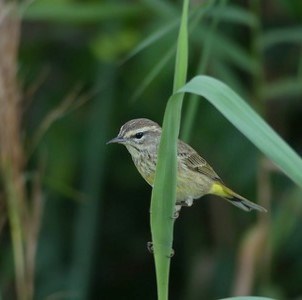
Appearance: Palm Warblers are olive-brown with patches of bright yellow under their tail and throat. There are two variations of this species: the “western” Palm Warbler has a pale, faintly streaked belly and a light-colored eyebrow, while the “yellow” Palm Warbler has a more yellow belly and eyebrow. During the breeding season both variations develop a rust-colored cap on their head. Size: Palm Warblers are 4.7-5.5 inches in length with a 7.9-8.3 inch wingspan. They weigh 0.02-0.03 lbs. (0.3-0.5 oz.) Habitat: In the winter, Palm Warblers can be found in Florida’s open areas with scattered trees and shrubs, such as marshes, prairies, and patches of younger trees. They migrate to Canada and some parts of the northern United States for the summer breeding season. Diet: Much of the Palm Warbler’s diet consists of insects, such as beetles, ants, and spiders. They often forage from the ground but will also forage in trees and shrubs, occasionally flying out to catch an insect mid-air. In the winter, Palm Warblers will also eat berries and seeds. Reproduction: Palm Warblers form pairs during the breeding season, with some males having multiple mates. The female lays 4-5 eggs that are incubated for 12 days. The task of feeding the young birds is shared by both parents. 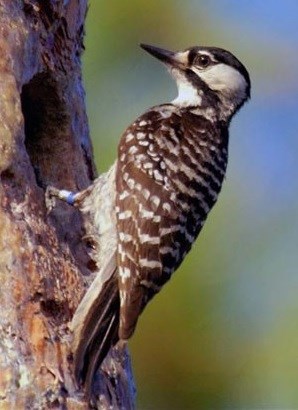
Appearance: The Red-cockaded Woodpecker is characterized by a large white cheek patch and ladder-like black and white bars on its back. The red "cockade" that gives the species its name is a thin line of red along the top of the male's cheek patch that is usually only visible when he is excited. Size: Red-cockaded Woodpeckers are 7.9-9.1 inches in length with a wingspan of ~14 inches. They weigh around 0.1 lbs. Habitat: Red-cockaded Woodpeckers are found in mature pine forests with an open understory. In southern Florida they can be spotted in areas of mixed slash pine and bald cypress trees within grassy wetlands. They primarily nest in cavities they excavate in living pine trees, usually ones where red heart fungus has softened the heartwood. Diet: Red-cockaded Woodpeckers eat insects and other arthropods they forage from on and under tree bark, as well as some seeds and fruits. They use their bill and occasionally their feet to remove bark, searching for insects underneath. These woodpeckers often forage in groups, with males primarily found on the branches and upper trunk of a tree while females forage on the lower trunk. Reproduction: Red-cockaded Woodpeckers are monogamous, often mating for life. The female lays 2-5 eggs that are incubated for 10-11 days. Incubation and caring for the young is performed by both parents, as well as 1-4 non-breeding individuals, usually the breeding pair’s male children from previous seasons. |
Last updated: December 18, 2023
